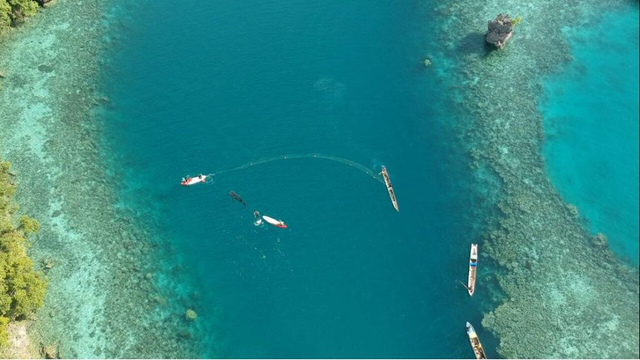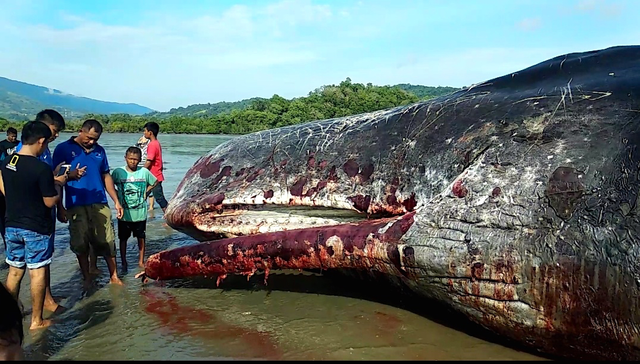Whale Trapped Sharks

The location of the lagoon of Sombori Island, Mbokita Village, Menui Islands, Morowali, Sulteng are somewhat sheltered and around the shore of a rock whose depth is affected by the tides making the evacuation process of stuck whaling sharks hard to do. Photo: Ifan Bente / PSDKP Wilker Kendari / Mongabay Indonesia
A Whale Shark (Rhincodon typus) was found trapped in the lagoon of Sombori Island, Mbokita Village, Menui Islands Sub-district, Morowali District, Central Sulawesi, on February 4, 2018. The whale sharks (juveniles) can not get out because of the shallow waters and their aggressive nature.
Seen a number of divers trying to measure the length of fish and trying to lead to the sea off but constrained water conditions that recede with aggressive fish nature.
The next day, around 7:00, the team then identifies the Whale Shark. Data and information obtained that the whale shark is still classified saplings (juveniles) with a length of 4.2 meters male sex. Weighs an estimated 600 kg. Colored black white spots. The team then did a photo taking ID as the Pope Shark recognition data base. From the existing conditions, the condition of fish is still in the category of Code 1.

In the rescue of marine mammals stranded themselves there are a number of codes provided that aim to facilitate reporting. For example, Code 1, which means the animal is alive. Code 2 means the animal has just died and there is no fresh dead. Code 3, the carcass begins to rise (moderate decomposition), Code 4, the carcass is decomposed, and Code 5, the carcass has become a severe decomposition.
Rescue evacuation is done by herding fish using small fish bait. Until the afternoon, at around 17:00, the Pope's shark has not been successfully removed from the lagoon due to a number of obstacles. In addition to its somewhat sheltered location, also around its shore corals whose depths are affected by the tides.

A Sperm Whale died wounded in the waters of Bombana, Southeast Sulawesi. Photo: Kamarudin / Mongabay Indonesia
Whale shark (Rhincodon typus) itself is a plankton-eating shark which is the largest fish species. This fish has a habit of eating by filtering seawater resembling most types of whales. It is also called the latitude namageger (from the Java language: starred back) and Hii Tutulkarena to the color pattern on the spotted back.

A researcher is diving with whale sharks in the Bay of Cendrawasih, Papua. Photo: Shawn Heinrichs / Conservation International
These whale sharks wander in tropical oceans and warm seas, and can live up to 70 years of age. This species is believed to originate from about 60 million years ago.
Regardless of its large size, the Pope's Shark is known to be harmless to humans and sometimes lets divers ride it, though this action is not justified by sharks and conservationists.

Begitulah Indonesia yang takkan pernah habis dengan cerita alam, negeri yang selalu memperlihatkan keindahan alam raya nya. Laut yang indah serta pergunungan yang indah.
Nice post 👍 lestari alam ku, lestari laut ku.
It is so sad to see the ever increasing number of the beautiful creatures laid up on the beach, and often times dying. Unfortunately, this spike is highly correlated with the use of sonar technology, which interferes with transmission of data between organisms in the ocean. Thanks for the post, it is definitely redeeming to see good people protecting the wildlife and doing what they can to preserve its habitats and wellbeing.